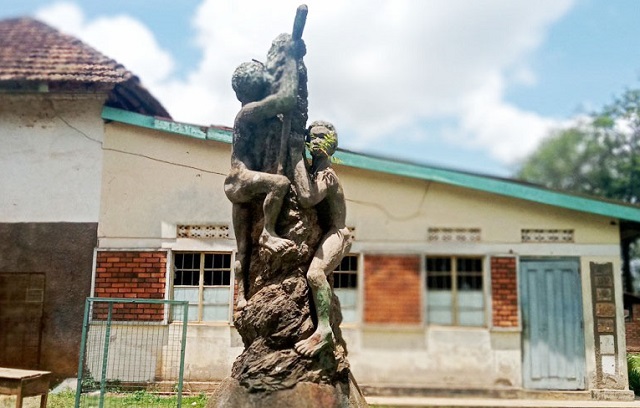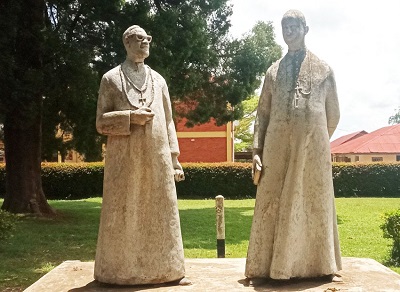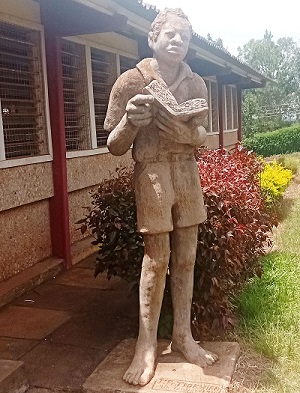
The sculpture park at the College is a representation of the early training in creative thinking and practice among the students.
Kampala, Uganda | Dominic Muwanguzi | You may be convinced to feel like you are on a visit to an open air sculpture park in Paris or Germany once you make your way through the main gate of St. Henry’s College Kitovu. The school located approximately 130km from Kampala in the South Eastern district of Masaka, has sculptural artworks dotting every corner of its vast campus. The sculptures either communicate the history of the school that was founded by the White Fathers in 1922, or convey the significance of education within context of Christian values and academic excellence. The message is underlined by the astonishing technical dexterity of the young artists who produced the art; leading the visitor to argue against themselves if these were really created by the students.

The sculpture “For Greater Horizons” sitting conveniently outside the school campus will immediately capture your attention. It is a composition of three young boys dressed smartly in short sleeved shirts and shorts, with books in their hands and matching forward. This idea of moving forward together suggest sharing a common vision of success: reaching the greater horizons. The three boys gaily swing their hands as they move forward and one of them stretches his hand out as if beckoning on others to join them on their Journey to success. The sculpture was built in concrete by the students with the guidance of their tutors. The idea of its location beyond inviting immediate attention from the visitors was to underscore the objectives of the College: to provide education that will enable students reach greater horizons.
Once inside the school compound, sitting almost next to the Staff room and within a well manicure garden is the Founders’ Monument. The monument depicts two European clergymen Fr. Adrian Laberge and Bro. Eugene Paquette dressed in cassocks. Their body posture reveals men of vision and wisdom; emphasized by the bespectacled Fr. Laberge on the left and the book in the hand of Bro. Eugene on the right. The artists Expedito Mwebe and Alex Drani; both students at the time; exhibited early signs of studio prowess by sculpting the statue with exceptional craft. The sturdy monument vividly captures the personality of the missionary priests reflecting their gentle, pious and amiable character that became the real foundation for the success of the College. In founding the school, these two illustrious men envisioned such qualities for all the students.

Another figurine that invites the attention of the visitor is of a young man standing next to the school library reading a book. The figurine captures the essence of reading for which it was built to represent. Though it may be simple in composition- with not much technical ingenuity involved like in the Founders Monument and For Greater Horizons sculpture- its representation of the idea of reading next to the school library make it relevant and conspicuous. Nonetheless, one may marvel at the gothic like sculpture standing in front of the first art room at the school. The Untitled sculpture, dated 1967 by J.T Kivubiro, has two figures climbing a tower. The artist effectively captures the figures’ earnest desire to get onto the top. Perhaps, the tower is a representation of the pinnacle of success in life that can be achieved through struggle and determination. By the facial expression on their faces, the two young men seem to be fully determined to realize their objective to get to the top. Their lean muscles exposed by their tight grip onto the tower, allude to their vitality and self-assuredness. The sculpture is a master piece in the way it was executed to touch the emotions of the viewer.
The medium used for these sculptures is concrete that serves two purposes: To ensure that the artworks are permanent and can be appreciated by different generations of students who enroll at the school; and two, to represent the idea of academic strength which the school has become known for throughout the decades. The College has contributed to the biggest number of artists in Uganda. It has also equally produced a sizeable number of Engineers, Doctors, Professors and Lawyers.
The sculpture park at Kitovu is a representation of the early training in creative thinking and practice among students. This is critical if the young learners are to achieve their full potential in life. Notably, all the students who built these artworks went on to excel in life in the different disciplines they qualified in. As one marvels at the prodigious qualities of the artists, they should reflect on the time, creativity and thought process that went in the production of the sculptures. These immeasurable qualities are the reason why the school still ranks as number one in the region even after a century of its existence.
 The Independent Uganda: You get the Truth we Pay the Price
The Independent Uganda: You get the Truth we Pay the Price


